An orthopedic doctor may prescribe a back brace for a range of conditions. For example, a doctor might recommend a back brace to treat scoliosis which is a lateral curvature of the spine. They might also prescribe a back brace to help a patient heal after surgery. Or, perhaps you chose to purchase a lower back brace to provide lumbosacral support while lifting heavy boxes at work. In any case, a back brace is meant to improve spinal health and reduce back pain and problems in the future. For many patients, a back brace offers a non-invasive solution to a painful back condition.
If your spine doctor has prescribed a back brace, also called an orthotic, you may be wondering how it will affect your life. It does take some time to get used to wearing a back brace, but before you know it, it will become a regular part of your routine. It helps to maintain a positive attitude and remember that a brace is meant to help you enjoy better health long-term. Your doctor is there to answer any of your questions and provide support throughout the process.
Properly wearing your back brace will ensure it works as intended. Similarly, caring for your brace will keep it in excellent condition, so it’s as effective as possible. We’ll look at tips for wearing and caring for your back brace to help you enjoy a successful outcome.
Who Wears a Back Brace?
A back brace serves several purposes for a range of conditions. Generally, its primary role is to limit spine mobility and provide support. For example, back braces are commonly prescribed for adolescents who have been diagnosed with scoliosis, if the child is still growing and the curve of their spine is between 25 to 40 degrees. A scoliosis brace is designed to prevent further curving of the spine as the child grows, with the hope to prevent the need for surgery in the future.
When used as instructed, bracing has been shown to stop curve progression in about 80 percent of children with scoliosis. For it to be effective, the brace may need to be worn as much as 23 hours every day until the child stops growing. As the child grows, they will spend less time wearing the brace and will no longer need the brace once they are mature.
Other conditions that may benefit from wearing a back brace include:
- Lower back pain
- Post-operative healing
- Vertebral compression fracture
- Spondylitis
- Osteoarthritis
- Muscle strain
- Spinal stenosis
- Herniated disc
Types of Back Braces
Your doctor will prescribe a custom-fitted back brace for your specific condition and body shape. Generally, braces are either rigid or soft. Rigid braces are like a plastic shell that fastens with Velcro straps. Soft braces are elastic and may also use Velcro straps for fastening. A brace either functions to straighten curves in the spine or support the spine to help a patient heal or avoid an injury. For example, a patient might wear a plastic brace after surgery or a fracture to limit movement of the spine. Although your doctor will choose the right brace for you, here are some examples of different braces used to treat scoliosis:
- Wilmington brace and Boston brace: These braces are styled like jackets and worn underneath clothing. They cover the torso from the armpits to the hips and are made of rigid, lightweight plastic. The Wilmington brace closes in the front and is specially molded to fit the patient’s body. The Boston brace closes in the back and is available in a variety of sizes and customized with pads.
- Rigo-Cheneau brace: This brace is a custom-made plastic brace that may be used with the Schroth Method. The Schroth Method is a type of physical therapy used to treat scoliosis.
- Charleston bending brace: This brace is made of plastic and is only worn at night. It’s used to help with lower back C-shaped curves.
- Milwaukee brace: This brace was the first type of brace used to treat scoliosis, and it is rarely prescribed today because it is more difficult to wear than other braces. It involves plastic that wraps around the hips and waist and vertical bars that attach to a ring around the neck.
There are many types of back braces designed for different conditions. For instance, you might purchase a non-prescription back brace to improve your posture and provide support while working at your desk. Non-prescription braces are often made of a flexible material in the style of a corset or belt. You can adjust these types of soft braces on your own, and they may help relieve lower back pain. Nevertheless, it is best to speak with your orthopedist to determine the most effective and safe back brace for your condition.
Tips for Wearing a Back Brace
Your doctor will instruct you on how to wear your brace. It’s important to wear your brace correctly, so it is effective. Some braces, like those for fractures, might need to be worn 24 hours a day. However, it is often okay to remove a brace for short periods of time to bathe or to allow the skin to breathe.
Most individuals do well with their brace, but they can feel uncomfortable at first. Your doctor might recommend a schedule for wearing a brace until you get used to how it feels. For example, a child who has scoliosis might wear a brace for two hours for the first day, and by the end of the week, they might wear it for the full prescribed amount of time.
Although your doctor will guide you, here are some tips to keep in mind.
1. Ask for Help
Some braces are too difficult to put on or remove without assistance, especially if you suffer from back pain. Ask a friend or family member to help you with your brace if possible.
If you do not have anyone to help you, you can put the brace on yourself without further straining your back by using a chair. Place the brace on a chair with the wings open and sit down with the wings on either side of your body. Then, stand up while holding the wings and secure them in place. This way you do not have to reach behind you.
If you have a Wilmington brace, which opens in the front, you can put the brace on by yourself – although you may need help at first. To do so, sit on the bed with the brace open in the front and loosely around you. Next, lie down and correctly position your body in the brace. Pull the straps through the buckles and lock them into place, starting at the bottom. Once you know your brace is correctly in place, you can get dressed. Wear your brace as tightly as possible because a loose brace can cause friction and irritation.
2. Wear a Shirt Under the Brace
Wearing a shirt under your brace will help prevent skin irritation. Choose a shirt that is:
- Clean
- Tight-fitting
- One hundred percent cotton
- Without side seams
- Extends the length of the brace
Make sure there are no wrinkles in the shirt, and it is pulled down snugly.
3. Keep Your Skin Clean
A back brace is designed to fit tightly, so it is normal to notice red areas where the brace applies pressure. However, making sure to keep your skin clean will help prevent blisters or raw skin under the brace.
Wash the skin under the brace every day to get rid of dirt buildup. Use baby wipes to make sure your skin is clean after activities or as you go about your day. If you notice your skin is pink for more than a half hour, your doctor may need to adjust the brace.
4. Apply Rubbing Alcohol
Your skin will toughen up where the brace applies the most pressure. Rubbing alcohol can help toughen your skin and prevent skin breakdown and severe irritation. All you need to do is apply rubbing alcohol with your hands to the part of the skin where the brace touches. You will only need to apply rubbing alcohol until your skin toughens, which usually happens two to three weeks after you begin to wear the brace.
5. Avoid Wearing Lotion Under the Brace
It’s important to keep the skin under the brace as dry as possible. Too much moisture can cause irritation and lead to sores. For this reason, avoid using creams, lotions or powders on the skin beneath the brace. You might apply a dusting of cornstarch to the skin during hot weather or if you are sensitive to rubbing alcohol.
6. Always Wear the Brace as Prescribed
Your doctor will tell you when and how to wear your brace depending on your condition and the type of brace prescribed, and it is critical to follow their orders so that the brace is effective. Your doctor will tell you:
- How many hours a day you need to wear your brace
- What activities you can do with or without your brace
- How to correctly wear your brace
- If you can wear your brace in the shower
- If you need to sleep in your brace
- If you need to put the brace on before getting out of bed
Follow your doctor’s instructions for the best results, and call them if you have any questions or concerns.
7. Wear Loose Clothing Over the Brace
Many back braces are easy to conceal under clothing. You can still keep your sense of style with your brace, however, wearing loose clothing is typically more comfortable.
8. Stay Cool
Some patients claim that staying in air conditioning makes it more comfortable to wear a brace. Try to stay cool when it’s hot outside as much as possible.
9. Stay Positive
If you feel discouraged, keep in mind that your brace is meant to improve your health and your life. Also, remember that there is plenty of support available to you to help you along the way. When it comes to back problems, you are not alone. The majority of Americans will experience some sort of back pain in their life.
Wearing a back brace does not change who you are, but it does affect who you will become.
Tips for Caring for a Back Brace
Your back brace should come with specific cleaning instructions to keep it in shape and make it last as long as possible. However, most braces are not meant for machine washing and drying. Generally, taking care of your brace is easy and does not require much time. Here are a few tips to make sure your brace stays in good condition.
1. Clean With Soap and Water Daily
Cleaning your brace daily will keep it free of dirt, odor and bacteria. To clean your back brace, remove any panels or padding and clean all parts separately with water and mild soap by hand. Do not use bleach or harsh detergents on your brace. Make sure your brace is free of soap and completely dry before putting it back on.
2. Apply Rubbing Alcohol Once a Week
Applying rubbing alcohol is an easy way to remove soap residue from your brace and prevent bacteria growth. Simply wipe the brace down with a cotton ball soaked in rubbing alcohol. If your brace contains a foam liner, like a Boston brace, wipe the foam with rubbing alcohol every day. Rubbing alcohol dries quickly so you will not have to wait long to put your brace back on.
3. Check for Wear
It’s natural for back brace straps to wear over time. Regularly check your brace for any worn straps or tears, and let your doctor know right away if any of the components need to be replaced. An orthotist should be able to replace the straps easily.
4. Use a Lint Roller
Dirt and debris might accumulate in the Velcro straps. Use a lint roller to remove any unwanted materials from your back brace and ensure the straps are secure and in their proper place.
When to Call Your Spine Doctor
Your brace should be snug, but not so tight that it causes pain, bruising or other issues. If you experience any of the following, call your doctor – you may need to have your brace adjusted:
- You develop sores or redness that last longer than a half hour.
- Breathing or eating is difficult.
- You develop a rash under the brace.
- Your weight changed, and the brace is too tight or too small.
- The brace causes pain or new pain in any area of your body.
- Any part of the brace is worn and needs to be replaced.
- You have questions or concerns about your brace.
Contact the Spine INA Today
Every brace, just like every individual, is different. Your doctor will choose a brace custom designed for you and your needs. They will guide you throughout the process and answer your questions every step of the way. As a patient, your job is to attend routine check-ups to ensure the brace is working correctly. Your doctor will make any adjustments as needed.
If you suffer from back pain and want to live life comfortably, reach out to us at the Spine INA. Our spine specialists are doctors who care and understand the importance of fast, effective relief from painful spine conditions. Using compassion, extensive experience and state-of-the-art technology, our board-certified specialists are qualified to successfully treat your back pain. To learn more about our treatments or to make an appointment, contact us today.
This content was medically reviewed by Baher Yanni, M.D, on January 10th, 2019.
Resources:
https://kidshealth.org/en/kids/scolio.html
https://www.aans.org/Patients/Neurosurgical-Conditions-and-Treatments/Scoliosis
https://www.spine-health.com/treatment/alternative-care/when-consider-back-brace
https://bestbackbracesonline.com/how-long-should-you-wear-a-back-brace-things-you-need-to-know/
https://www.spine-health.com/treatment/alternative-care/how-use-and-wear-lower-back-brace
https://cpo.biz/docs/instructions-boston-brace-wear-and-care-guide.pdf
Center for Prosthetic Orthotics, Inc.
https://www.choc.org/orthopaedics/spine-center/scoliosis/bracing/
https://www.summitortho.com/services/bracing-orthotics/bracing-care-information/back-brace-2/
https://www.everydayhealth.com/back-pain/spinal-bracing-for-back-pain.aspx
https://www.scoliosis.org/bracing-for-adolescent-idiopathic-scoliosis/
https://kidshealth.org/en/teens/scoliosis-brace.html
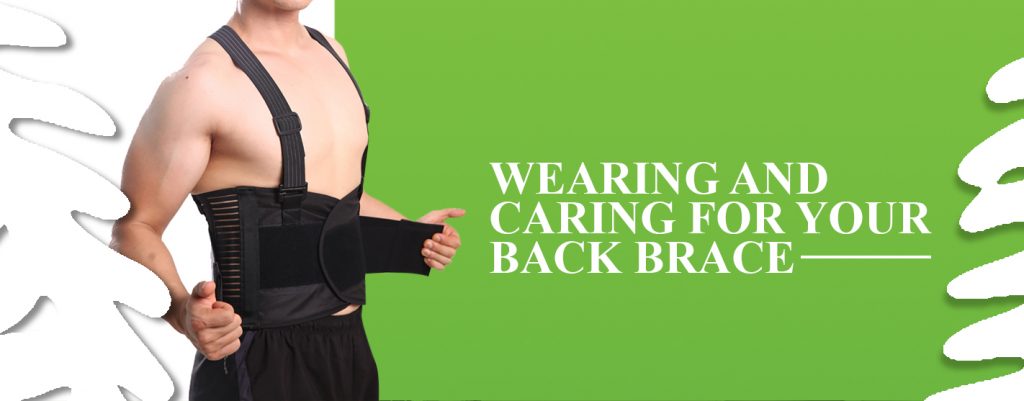
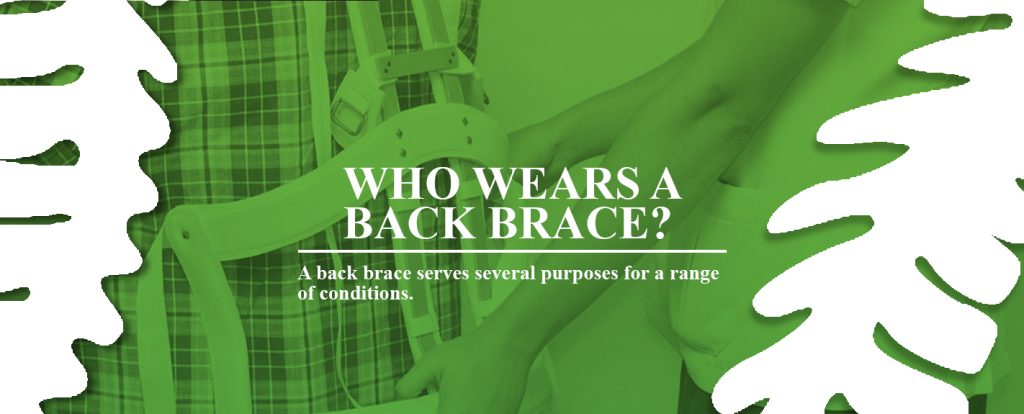
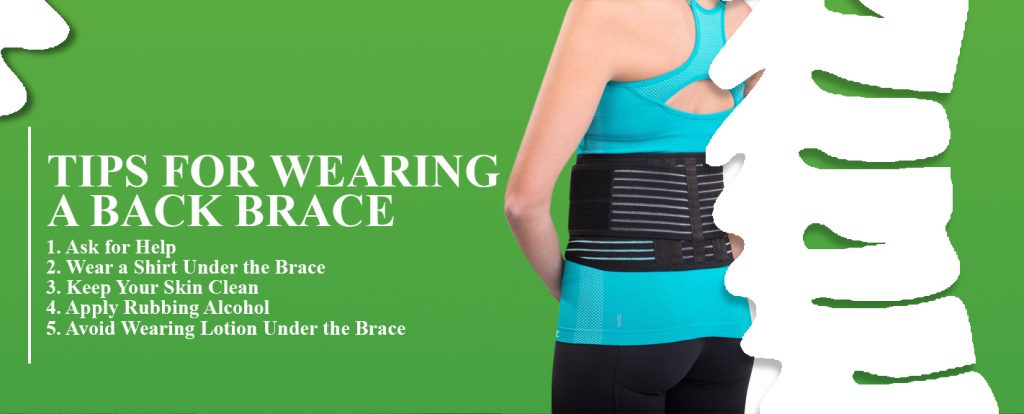

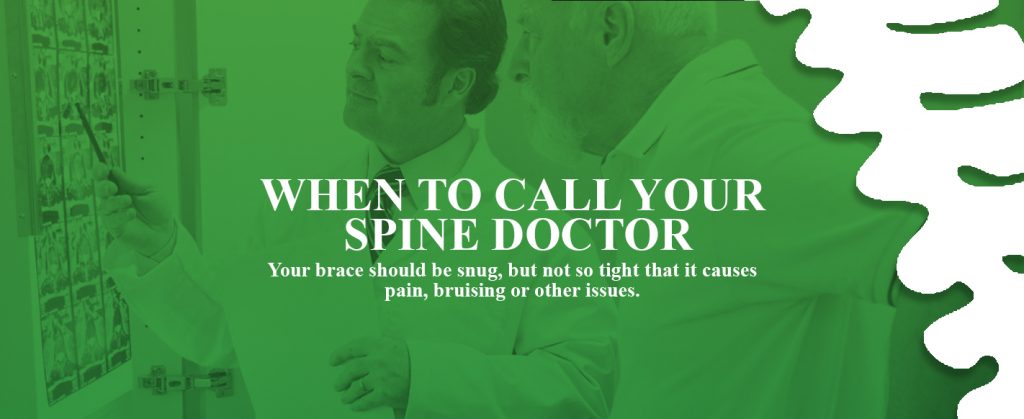
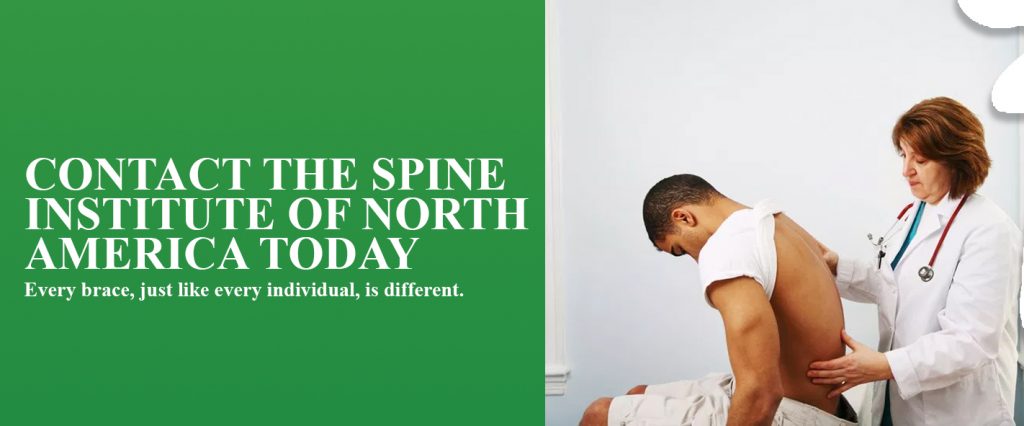









My husband suffered a compression fracture of the L1 and has been fitted for a brace to wear while recovering. He seems to have sore areas on the sides of his back from the lower rim of the brace itself. Is there any type of padding we can use along the lower edge of the brace to soften it?
Hey there! We’d be happy to help out with answering any questions you may have – please give us a call to learn more.